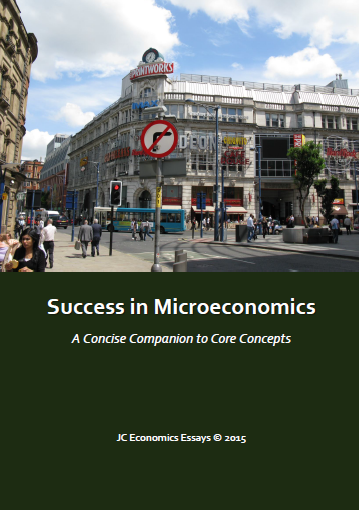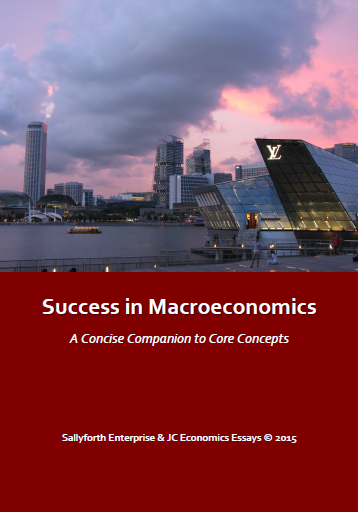Allow me to introduce the next economics e-book in my series, "Success in Macroeconomics: A Concise Companion to Core Concepts".
Written by myself (the editor) of the popular, useful, and relevant economics blog, JC Economics Essays, "Success in Macroeconomics" is a clear cut, concise companion to core economic concepts and theories for success in understanding Macroeconomics simply and effectively, which will help students gain an edge to excel academically in their economics examinations.
Often, students want a clear and simple guide or effective lecture notes that provide the main arguments and explanations of key economics concepts, rather than a long, verbose textbook. They often lament that their school economics notes sometimes give a deluge of information, or an overload of economics case studies, and they are unsure of what the core economics content is, or what economics theories and concepts they should be focusing on for their studies.
Since 2012, I have heard this common comment over and over (and as well as the reverse comment, incidentally, that some other junior college's economics lecture notes are totally in point form and need students to fill in the blanks, so as to keep them awake during econs lectures - such clever teachers).
Often, students want a clear and simple guide or effective lecture notes that provide the main arguments and explanations of key economics concepts, rather than a long, verbose textbook. They often lament that their school economics notes sometimes give a deluge of information, or an overload of economics case studies, and they are unsure of what the core economics content is, or what economics theories and concepts they should be focusing on for their studies.
Since 2012, I have heard this common comment over and over (and as well as the reverse comment, incidentally, that some other junior college's economics lecture notes are totally in point form and need students to fill in the blanks, so as to keep them awake during econs lectures - such clever teachers).
It's a legitimate issue: what learning resource provides a clear and simple economics guide that summarises key concepts and theories needed for the A levels?
My e-book provides an effective solution - how?
My concise guide provides simple yet effective explanations of key economics concepts, and entire arguments in paragraph form, for easy learning and retention.
With this targeted solution, writing argumentative paragraphs or economic analysis in essays becomes simply more effective and efficient.
Without long wordy paragraphs and additional filler information, this concise companion to core macroeconomic theories provides clear definitions, word-for-word explanations, and effective theoretical analyses of various macroeconomic issues.
What will you learn?
In this effective yet concise guide to core A level macro-economic theories and concepts, students will learn:
(1) Clear, concise, easy-to-memorise definitions to highly important macroeconomic concepts and theories often tested in economics tests and examinations
(2) Clear, accurate, step-by-step arguments to make a convincing economic case, either for or against an economic position, on a diverse range of macroeconomic questions and issues
(3) Theories on major macroeconomic problems and how governments theoretically could implement impactful economic policies to address these macroeconomic problems and pursue their macroeconomic objectives
(4) The clear, step-by-step arguments to make to explain the mechanisms of the economic policies and the analysis of their limitations, with specific arguments to make for specific policies
(5) Commonly used economics diagrams, with detailed yet simple explanations, that you can draw and utilise to analyse questions
(6) Useful and relevant, yet simple to understand, concise economic information for economic analysis on a variety of common macroeconomic issues
How a book helps students is often dependent on how it is used, so let me share some useful suggestions for your consideration. (Don't worry, I have also included a small section in the e-book to remind readers of how best to utilise the resource to reach their fullest potential.)
First, this book is an excellent complementary companion to supplement a traditional economics education, because it focuses students' attention on core macroeconomic issues and useful concepts.
It can be used for additional reading. Usually, strong economics students already have a good understanding of the subject, so they can just read this book from cover to cover. It will still help them, a lot!
Secondly, Success in Macroeconomics can be alternatively used effectively as a set of simple yet clear-cut notes for easy memorisation for quick success in economics examinations.
This would make this guide more significant as a revision toolkit for examination preparation.
With concise yet incisive arguments that are easy to understand, yet pack an impactful, powerful punch, with relevant theories and concepts, this economics book can be used for effective examination preparation.
If you want to learn A level Macroeconomics more effectively, do click on the link and get this useful guide now.
In Success in Macroeconomics - A Concise Companion to Core Concepts - you will be receiving:
Pages: 68 pages including cover pages
Chapters: 28 chapters
Edition: 1st Edition, 2015
Details: Full colour; high resolution; with varied economics diagrams
***
JC Economics Essays supports social enterprise!
This book was kindly contributed by JC Economics Essays to Sallyforth Enterprise, and some proceeds from the book will be given to support and build up less privileged communities. Sallyforth Enterprise is a social enterprise that strongly supports social enterprises, volunteerism, and charity work. Part of the proceeds from this book will be given to charity, to build up less privileged communities, especially in less developed economies and rural communities. In particular, women and children are supported by such funding. Social enterprise can and should be a force for good.
Thank you for your kind and invaluable support, which will definitely go a long way to greatly supporting the needy and vulnerable.
JC Economics Essays - Here on this economics learning site, you will find economics education and learning resources for "A" levels, especially H1, H2, H3 A level Economics, and also many economics essays, also including undergraduate, and post-graduate and master's economics essays. Fundamentally, JC Economics Essays is mainly an economics essays blog that shares contributions and economics articles to help students learn economics and how to write excellent essays. Thank you for reading, and cheers.




